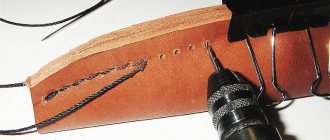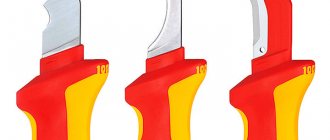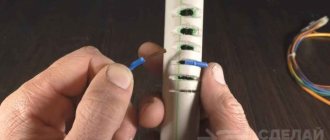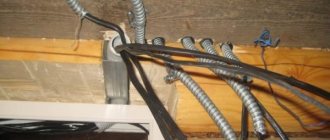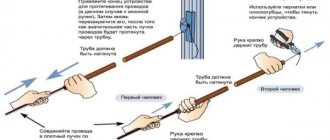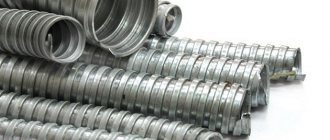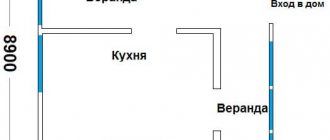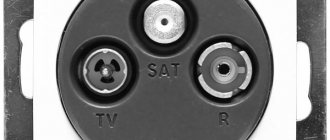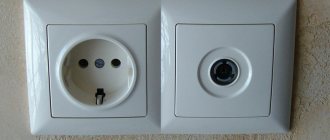An electrician's knife is a cutting device used to cut and separate the insulating protection of cables and wires. Tools come with a heel, that is, a smooth metal washer on the tip of a curved blade. There are also knives with a “beak” or hook.
The tool may have one sharpened blade or both. Knives with a heel are the most convenient, since the part protects the conductive threads of the cable from damage.
But regardless of the type, the instrument must weigh up to 125 g, 155-220 mm long, with a short blade and a protective case. It is desirable to have a non-current handle; at a minimum, it should be comfortable and not slip in your hands. The most common products are KVT, LS-55, Knipex, NWS, Jokari. If desired, you can make a repair knife yourself.
Types of electrical installation knives
A cable stripper does not have to have a straight blade.
Often, to remove insulation you need to make circular cuts, which are more convenient to make with a curved blade. You can get by with a regular knife, carefully cutting the top layer of insulation along the wire, and the inner layer using circular movements, then removing the braid. However, if the parameters of the knife blade and handle do not meet the necessary requirements, you can easily damage the wire strands, especially if they are thin. To make it easier to make circular cuts, the mounting knife is equipped with recesses corresponding to different wire sections.
The cable stripper must meet the following requirements:
- The repair knife should be small for easy handling in hard-to-reach places (panel, cabinet). The blade should also be small so that when working with a bundle of wiring, you do not accidentally damage it by cutting off excess. This tool makes it easier to strip wires, especially thin ones.
- The cutting edge must be straight. It will be easier to cut a double-insulated cord if you only need to remove the outer layer and leave the inner one intact.
- The handle may not have an anatomical shape, the main thing is that it allows you to determine the tip of the blade by touch. The material of manufacture must be dielectric and also durable (plastic, carbon fiber) to prevent electric shock during installation work.
- The blade is made of carbon steel. This will allow you to maintain the required blade sharpness for a long time.
The highly sharpened blade of an electrical knife only complicates minor manipulations with wiring, especially in a dark and cramped room.
The fitter's fingers will involuntarily touch the sharpened side of the blade, and damage to the metal strands of the wire will also occur.
When cleaning the cable, it is necessary to monitor the position of the blade in relation to it (maintain an acute angle), otherwise you can cut a core of soft metal (copper or aluminum). Removal of insulation should be carried out with light movements away from you, cutting off the braid in parts.
If the tool is purchased at a retail outlet, electrical technicians should pay attention to the voltage that the handle can withstand.
Varieties of design
Structurally, knives for stripping electrical wires can be folding or non-folding, with a straight or curved blade. In any case, the blade should be moderately sharp, there should be no burrs or notches on it, otherwise when stripping the cable, the wires can easily be damaged.
If a folding knife is used for electrical work, it must be equipped with a reliable lock so that when stripping the cable the blade does not fold spontaneously. The blade must be sharpened on both sides. It is desirable that the cutting edge has an internal rounding - this simplifies the removal of insulation from the wire.
As already mentioned, an electrician does not need too sharp a tool, since it is easy for them to cut fingers and also damage metal conductors. An overly sharpened blade can cause accidental damage to the insulation of the wrong wire that is being processed.
It is very important to strip the wire correctly. Many people cut the insulation around the circumference and then pull it off the core, but this often leads to damage to the metal part of the cable.
The insulating material should be cut using movements similar to those made when sharpening a pencil.
Stripping GOST and TU cables
Wires manufactured in accordance with GOST 31996-2012 and created in accordance with the specifications differ in that in the second case the thickness of the conductive cores and insulating protection may be less than those required by the standard. That is, stripping such a cable must be more careful, and the tool for the job is selected accordingly.
The process of removing insulation from a TU wire is easier, but there is a danger of damaging the core. Therefore, you should choose a knife that is not the sharpest, with a small heel or no heel at all.
When working with a cable made according to GOST, it is better to use a high-quality and sharp tool. The sheath of such a wire is usually dense and rigid, making it more difficult to remove. In addition, it fits more tightly to the conductive core.
How to choose a cable cutting knife
You should choose a knife for cutting cables according to several criteria:
- The diameter of the wire that needs to be stripped of its insulation. These values differ, so a specialist may need to have several knives - with larger and smaller heels, or with a “beak” or hook-type blade. And for home use, it is better to buy a knife with a medium-sized heel, since you will have to work with a flat cable like VVG. If the wire is round, this part should be larger.
- Comfortable handle. It is better if it is non-slip, with rubberized inserts. Insulated handles are preferable, even if you need to strip a dead cable. They are safer.
- Blade sharpness. It must match the thickness and rigidity of the wire's protective sheath. If the material being cut is thin, you do not need a very sharp tool; it is easy for them to cut themselves and damage the conductive threads of the cable.
- Durability. Jokari and Knipex are suitable for frequent use; they are not only of good quality, but also serve for a long time during active work. If the use is one-time or rare, you can take KVT. It is quite strong, sharp, and will not break at the first strong pressure.
Watch this video to learn how to remove insulation from electrical cables:
Criteria for choosing an electrician's knife with a heel
A cableman's knife for stripping insulation is a tool that has a large number of varieties that are widely represented on the market. Their production is carried out not only by domestic brands, but also by foreign companies. The tool should be safe and simple, so when purchasing it, you need to consider the following factors:
- Blade shape . It is desirable that it be in the form of a hook, equipped with a heel at the end. This type of tool is convenient for processing cables with a round cross-section. As for the shape of the blade, it will make it possible to cope perfectly with flat cables. The short and strong blade fits perfectly between the veins and rests on them during cutting, so damage is excluded.
- The design of the knife itself . Many models, especially those with a heel, have an awkward design - the blade has to be covered with a special cover. Therefore, it is important to ensure that the model has a folding device, which is comfortable to wear and avoids injuries.
- Manufacturer . The choice of cable knives is very large. The models are very similar in their characteristics and designs. They are intended for both domestic and professional use. Professionals are recommended to use insulation pullers from brands such as KVT, NWS, Sata, Shtok.
- Shape and dimensions of the handle . Many manufacturers produce cable cutters with uncomfortable handles. Those models that are more expensive are made with handles made of plastic that is pleasant to the touch and have a comfortable grip with grooves for the fingers. This all increases the comfort of working with the tool.
For professional use, it is better to stick to tools from well-known brands.
For example, a set of knives for cutting NNRK (EMI) cable. Using it, you can make longitudinal and transverse cuts in aluminum and lead sheaths with a thickness of 2 to 5 mm and easily remove it from a cable with a diameter of 25−60 mm. Also in a large assortment of NNRK for performing complete cutting of cables made of cross-linked polyethylene, the voltage of which is from 1 to 35 kV. Not only classic models are provided, but also innovative ones that will greatly facilitate this installation stage.
From A to Z". How to choose an electrician's knife (with a heel). The most detailed review.
Hi all. My name is Anatoly, welcome to my blog. I am the creator of the YouTube channel “Tool Box” https://www.youtube.com/user/YarServisStroy. Today we will talk about knives, but not about simple ones, but about “electrician’s knives” or those with a “heel”. Once upon a time, I also chose a similar knife for myself and came across a great variety of models. Some were different, some were similar and differed only in color. I read a bunch of forums where they mostly praised Knipex, and the competitor was either Chinese or KVT... In general, I bought myself Knipex. But doubts overwhelmed me, I kept thinking, maybe I could have gotten it cheaper???!!! And not to overpay?.. Then I was just starting to shoot videos, so I decided, why not compare them. This is how my first project on the channel called “Electrician’s Knife (with heel)” was born.
Then there were a lot of plans and we decided to buy all the types that were available. So on our channel there were such knives as Haupa, Sata, a knife from Aliexpress, KVT, Knipex, Jokari, NWS. And also a little later we bought TDM and a new KVT and Shtok. Now, in order.
- KNIPEX 9855
I bought it first, long before the project. What can I say about him? I liked it. Initially, it seemed to me that it had a weak sharpening, since many said that they cut easily with it. I tried to compare it with a regular office knife, but over time I realized that this was not correct, since the thickness of the knipex blade is many times greater than that of a segmented one. The heel is small, teardrop-shaped. Has a small angle relative to the handle. Removes insulation quite well. The cut is clean. I would like to say right away that this type of knives is intended mainly for stripping insulation from flat cables. But we, as experimenters, tried to shoot from everything. In general, if you take “TU”, it easily removes insulation from all flat and round ones. If it is “GOST”, then removing the insulation from a flat surface is difficult, on the verge, you have to put in quite a lot of effort. Everything is clearly shown in the videos, links to which I will attach at the end of the article. Well, for those who were interested. Removes insulation from UTP, NYM, PVA, SHVVP, etc. It's hard to say what he's not filming. But again, it’s more convenient to shoot from what it’s intended for, which is flat.
- HAUPA, SHTOK, KVT, Licota, Neo, etc.
HAUPA 20 00 07. This was the first and unsuccessful series, since the knife arrived with a scythe and an obscenely welded heel.
They changed the knife for us. But the quality remains the same. And honestly, if it weren’t for the YouTube channel, I probably would have taken the money. The first thing I want to say is that a huge bunch of knives are produced in this form factor. Our project will include Haupa and KVT. But there are also similar ones from STOK (we’ll look at the new version below), NEO, Licota, etc. They look the same, the difference is often in the name and color.
Now about the knife. I really liked the handle. Comfortable and fits well in the hand. It is two-component, red plastic, black or yellow rubberized part. The blade is about 5 cm long and has a sickle shape, with a metal heel at the end. What I didn't like. The heel is very large and flat compared to the Knipex. And there is no angle, it is welded parallel to the handle. The sharpening turned out to be good. But the above-mentioned shortcomings on the “heel” did their job. It is convenient to remove the insulation only from the “TU” cable, where it is heat-shrinkable, and accordingly there is an opportunity to put this “heel” somewhere. In GOST, the insulation is dense, and there is practically no distance between the cores and the external insulation; accordingly, there are fewer options for inserting this “heel”. Plus, the thickness of the heel is practically equal to the VVGng 2x1.5 cable, it is very difficult to remove the insulation from it. As for Haupa, we didn’t have this knife until the end of the project. At first we changed it because of the crooked heel. Then it got even worse. During the process of removing the insulation, my heel was broken. And it would be okay just once. They sent us a new one to replace the broken one, but it also did not pass the tests. Regarding KW. He reached the end, but this does not mean at all that he is better than the haupa. Here, in my opinion, it’s a matter of chance. The heel could fall off on everything, since these knives are made at the same factory. On the plus side. In one of the series, we re-sharpened the KVT, made the heel much smaller, and used Knipex as a sample. Looking ahead, the same procedure was later carried out by the plant, but more on that later.
- N.W.S. WEICON
NWS VDE 2043K. What is its feature? Firstly. This is not the first variation of this knife; if now it is yellow and red in a combination of plastic and rubber, then before it was just plastic.
Now Weicon is produced in the same variation with a different color, but still the same form factor. Well, you yourself understand that there are many companies, or rather brands, but there is only one knife for everyone.
Now for more details. I liked this knife tactilely. Doesn't feel bad in the hand. Recesses for fingers are appropriate. But if you compare it with the above samples, the grip is not so comfortable. Since here the cut of the handle goes perpendicular to the blade. And on the above ones at an angle. The heel is small and has an angle relative to the handle. There is only one minus. The sharpening failed. It's very difficult to start cutting. What's forward, what's back. After using this knife I realized that Knipex is sharp. Because of this sharpening, it is inconvenient to remove the insulation. As practice has shown, this happens. And this is more a defect than a pattern. Therefore, I advise you to check the knife when purchasing so as not to end up in such situations... And this applies to any brand.
Knife from AliExpress I had no luck with it either. Yes, it was the cheapest knife we bought. Its shape was copied from Knipex. Previously, it was produced in the same form factor by KVT and SHTOK.
What would you like to say about him? If you manage to get a sharpened copy, you won’t regret it, but if it arrives as stupid as ours, then it’s a waste of money. The shape is clear from the picture. The front part is the same as on the knipex. The handle is different. completely plastic. Again, it was originally copied from Knipex. We made two issues about this knife. Links to them will be below.
- SATA. TDM Electric etc.
We ordered Sata from Aliexpress. At first it seemed that it was similar to KVT, haupa, etc., but in reality it turned out to be different. We later purchased a similar knife under the TDM brand.
The most interesting. They turned out to be the same. That one doesn't work, the other doesn't work. If we had no choice with sata. They couldn't touch him. Things were better with TDM. The picture shows that we chose from everything that was in the store, but this abundance did not help. Either in China or in the store, there was only one problem, the distance between the heel and the blade. And there is only one reason, poor and low-quality welding. The knife cannot cut forward or backward. Yes, that's a good idea. It's really small and compact, but the execution lets us down. It let me down so much that I don’t even have words. You can also watch the videos in more detail.
- Jokari, Cimco, NWS, etc.
Jokari VDE Cable Stripper.
This is the most expensive knife we purchased for the project. It cost us about 4 thousand, with the price of a knipex being 2.5... Completely plastic, no rubberized parts. The heel is reminiscent of the aforementioned NWS, it feels like the upper is an upgraded version of that. From jokes. I ordered yellow, but it arrived red. There are no inscriptions. By removing insulation. It takes good pictures, on par with knipex. But the price is not affordable.
- New from KVT and STOK.
These knives came out recently. Essentially they represent a new version of the previous ones. They left all the best, and this is the hand. And they replaced the bad one. And then the blade. We made the heel smaller and gave it an angle relative to the handle. We made protection on the top of the blade. Well, they reduced the cap.
In our review we compared this knife with a Knipex. They compared not only externally, but also in terms of cable cutting. You can write a lot of things here, but, in my opinion, it’s better to see. Knipex or KVT? What's better to see? Knipex or KVT? What's better? New. KVT NMI-01(A) and KNIPEX KN 9855. Electrician's knife (with heel) #13.
That's all. Now the promised links to the project “Electrician’s Knife (with heel)” For those who are impatient. Final release. Comparison of Knipex, Haupa, Jokari, NWS, KVT, Sata and Stock. Final test. Electrician's knife (with heel) #10.
Well, a link to the playlist, where you can find a review of each knife individually. https://www.youtube.com/playlist?list=PLd8AHVweS4s8WYuV3a1xRuZNpJt5UdJ_v
Enjoy watching.
If you have any questions, I will be happy to answer them in the comments.
Types of stripping knives
There are a large number of different tools with their own specific features. This also applies to cable cutting knives. Products of this kind are divided into two types:
- to remove the outer insulating layer;
- for removing internal insulation.
To remove the external insulation, use a tool equipped with a special heel.
This specific device is only suitable for such work. Therefore, purchasing it will be beneficial for professional electricians who constantly perform similar procedures.
The rare use of a knife with a heel for removing insulation at home does not justify the rather large cost of purchase. Often such a tool is made by hand, using available materials.
A special knife with a heel, purchased in a store, is convenient to use. The rubberized handle allows you to hold it firmly in your hand, and thanks to special notches on the rubber coating, it does not slip out of the palm and fits well into it.
The blade is made of high quality steel. It is double-edged; you can dissolve isolation both from yourself and towards yourself, that is, in both directions. The end of the knife is equipped with a small plate called a heel and allows you to safely strip the cable without damaging the internal winding.
Its size is selected in accordance with the thickness of the wire. A knife with a wide heel is well suited for processing thick multi-core cables, and a device with a small heel can remove the insulating layer from a wire of any diameter. Therefore, the second option will be more universal.
The main function of the heel is to limit the depth of the cut when you have to work with double insulation: remove the top layer, but leave the inner layer untouched. The heel makes it easier to slide along the wire and prevents the blade from disturbing the internal wires. The disadvantage of such tools is their cost (1000-1500 rubles). It should be noted that it is better to strip flat cables with a knife with a heel, although it is used for different sections, but when cutting round ones, damage to the internal conductors is possible.
Electrician's knife with heel
An insulation stripping knife is a type of repairman's knife; it consists of an insulated rubberized handle with a limiter, a short blade rounded inwards, at the end of which a teardrop-shaped heel is welded, thanks to which these knives are called “knives with a heel.”
The main purpose of this tool is to cut the primary cable insulation. An electrician's knife with a heel makes it quite easy to remove the outer sheath of the cable without damaging the insulation of the cores themselves.
Using such a knife simplifies the process of cutting cables, saving time and bringing comfort in work. As you can see, every electrician needs a wire stripper.
How to make a knife with a heel yourself?
As we have seen, a repair knife equipped with a heel is a very convenient tool that has serious advantages. However, it has one serious drawback - the high cost, due to which many people cannot afford such a purchase.
If you have to do electrical work only periodically, as is usually the case in the household, purchasing a specialized tool is not practical.
However, you can make such an electrician’s knife with your own hands; this procedure does not present any difficulties. Let's take a closer look at how to do it and what we need for this.
Materials for work
To make a homemade knife with a heel for stripping wires, you first need to stock up on the accessories that are listed below:
- Blades for a stationery knife (2 pcs.)
- Aluminum profile from which the handle will be made. A piece of metal base from a mosquito net used in PVC windows is quite suitable.
- The rail is made of wood, which should be somewhat inferior to the profile in its cross-section.
- Soldering iron with POS solder and phosphoric acid.
- Diamond cutting microdisc.
- Bormashinka.
Having prepared all the necessary materials and tools, you can proceed directly to assembling the knife with the heel.
Manufacturing procedure
A homemade repair knife is made in the following order:
- Cut a spike on a stationery blade to which the heel will be attached.
- Grind off the excess sharpening so that only the edge remains sharpened.
- Sharpen the opposite side of the blade.
- Make a heel with a slot from a piece of the second blade that will correspond to the thickness of the cutting blade.
- Using a soldering iron and solder, attach the manufactured heel to the first blade. Give its edges an oval shape so that during operation of the tool it cannot damage the insulation of the cores and their metal base.
- Insert the blade into a piece of metal profile and secure it inside using a wooden strip with a cut.
- Drill a hole in the handle so that it is aligned with the one already in the blade.
- Insert a bolt into the hole and secure it with a nut on the other side.
At this point the work is completed, the tool is ready for use.
A slightly different technology for making a knife with a heel in the video:
Other devices
After removing the outer layer of insulation, it is usually necessary to remove part of the inner layer, for example, to solder it to the board or screw it to the terminals. This manipulation will be more difficult since the inner winding is usually surrounded by stranded wire, which consists of thin copper strands twisted together. In this case, you will need a type of tool such as a puller or stripper.
You can strip wires by removing insulation using special pullers, which are truly universal tools for working with wires.
Their device has several blades of different lengths and shapes, but the main element is a clamp, with which you can make circular cuts in the insulation of cables with different sections. It is convenient to use such tools, since you can manually select the desired diameter and not worry about damaging the conductor. To do this, the cable is fixed in the clamp, and the insulation stripper is rotated around it.
A stripper is a type of insulation stripping tool that is well known to electricians. They are very convenient for working with wires of different diameters, removing both the top protective layer and the inner one, adjusting the depth of the cut. Easy to strip thin cables. Often the stripper is equipped with additional devices, with which it becomes a truly multifunctional device.
A knife with a beak is endowed with a certain specificity. Not all electricians use it in their work. It is convenient for many, but not for everyone. The blade has a smooth bend shape, there is no heel. The beak-shaped inner edge makes it possible to make circular cuts in the insulation before removing it. With caution, since there is no heel, it can also be used for cuts along the wire. More often, experienced electricians use this device, since the depth of the cut is adjusted manually.
Advantages of a heel stripping knife
Today, a mechanic's knife can have a number of advantages. Thanks to this, it has become widespread among electricians.
To cut wires, strip their insulation, and strip live wires, you can’t do without a special electrician’s knife. An important requirement for an electrician's knife is the presence of an insulated handle, which allows work to be done under voltage when it is not possible to de-energize the line. The knife handle should indicate the voltage that the insulation can withstand. If you are interested, then you can read about press pliers for crimping sleeves.
Of course, in the absence of a special repair knife, several layers of insulation can be wound around the handle of an ordinary knife, but this insulation method can hardly be called reliable. If you have to work at height, and the tools are placed in a mounting belt, you can purchase or make your own knife with a sheath, which can be hung on the belt, and thus, it is safe to move and remove the knife by touch. By design, an electrician's knife can be:
- Foldable.
- Clumsy.
The knife blade can be straight or curved. The blade must be sharpened, without nicks or burrs, which can easily damage the wire core.
The knife most often used by electricians is a folding knife with a lock that prevents the knife from inadvertently folding. The blade of such a knife should be sharpened on both sides, and the cutting edge should be rounded internally, which facilitates the process of cleaning the cable from insulation. It is quite difficult to avoid damage when stripping a thin wire, so the insulation should be removed gradually. After stripping the core to the required length, the insulation is separated and cut off at the base. If you are interested, then you can read about heat shrink tubing.
Features and advantages of a mechanic's knife
This tool is designed for cutting cables, stripping them of primary insulation and removing insulating material from conductive cores. One of the main requirements for it is the presence of an insulated handle, without which working with electricity is fraught with consequences including serious electric shock. In addition, it must indicate the voltage rating that the insulation can withstand. If the knife does not have such a handle, then it can only be used when working with de-energized lines.
When performing electrical installation work, it is undesirable to use long and too sharp tools, otherwise, if the wires are tangled, excess cables can easily be damaged. In addition, it is better to perform small and precise manipulations with a short blade, which is well felt in the palm of your hand and is more convenient in cramped conditions.
If the cable has a double insulating coating, then if necessary, it is advisable to use a tool with a straight blade, the cutting edge of which is parallel to its main axis, to peel it from the outer sheath. Oblique knives are not suitable for these actions.
Electricians often use homemade knives, wrapping one of the edges of the sheet with some electrical tape. It is clear that there is no need to talk about the high reliability of such insulation.
If a specialist works at height, and the necessary devices are in a special belt, you can use a cutting tool with a sheath. Such a knife can be fixed on a belt, it does not interfere with movement and can be removed by hand at any time by touch. The sheath on a quality product is held tightly and does not fall off due to vibration, but can be easily removed with one thumb. However, many fitters do not like to wear them on their belts, considering it inconvenient.
However, almost all electricians note that the tool becomes less dull in a sheath and is easier to find by touch when it lies in a pile of other devices.
COMPARISON TABLE
BrandHeelHandlePrice
| Red LS-55 | Small | Plastic | 300 rubles |
| KVT NMI-01 | Big | Two-component | 1000 rubles |
| Knipex KN 9855 | Small | Two-component | 3100 rubles |
| Sata | Big | Two-component | 800 rubles |
| N.W.S. | Small | Two-component | 2200 rubles |
| Jokari | Small | Plastic | 3300 rubles |
How to make an electrician's knife with your own hands
You can make your own electrician's knife from two blades of stationery knives or a small piece of metal, since the working part of the tool should be small. In the first case, the sequence of actions is as follows:
- You need to cut out a rectangular piece on the blade of a stationery knife to form a fairly narrow protruding part (spike).
- An oval or round heel of the required diameter is cut out of another blade, and a line of contact with the tenon (slot) is drawn in it.
- Both parts are connected by soldering.
- The outer part of the heel needs to be sanded so that the surface becomes smooth and the shape is slightly convex.
- All that remains is to cut the linings out of wood or plastic to size and attach them using epoxy glue.
- It is better to sharpen the blade only from the outside and guide it away from you while working.
This primitive knife can be used if you need to repair the wiring at home, just be sure to turn off the power first.
A more advanced tool is obtained in another way:
- You need to take a strip of carbon steel 3-5 mm thick and make a drawing of a curved blade along with the heel on it.
- The workpiece is cut with a grinder or on a machine.
- Excess metal at the junction of the base of the blade and the heel is thinned using the same devices so that the last part stands out.
- Then you need to sharpen the blades (one or both).
- The heel is also sanded until smooth; it should be slightly convex, but without jagged edges.
- Handle linings made of wood, plastic, or rubber hose are attached to the blade.
The last stage is performed using epoxy glue, but for reliability it is supplemented with fasteners. For them, you will need to drill holes in the shank of the blade and on the linings themselves.
We recommend reading about how to choose a carving knife for working in the kitchen. From the article you will learn about the characteristics and purpose of a cutting knife, its varieties, cost, and rules for processing meat knives.
And here is more information about the pros and cons of electric knives.
There are many tools for removing protection from cables, and a specialist should only choose a good quality factory cutter. If you need to repair the wiring at home yourself, you can buy an inexpensive product with a heel or make it yourself. The latter is not difficult, and the materials for the knife are quite affordable.
